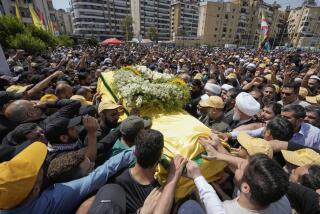Pakistani army investigating reports of Taliban leader’s death
- Share via
Reporting from Islamabad, Pakistan — The Pakistani army Sunday was investigating reports that Pakistani Taliban leader Hakimullah Mahsud may have been killed in a drone strike last month. If confirmed, the militant’s death could deal insurgents a severe setback in their battle against the government.
Army spokesman Maj. Gen. Athar Abbas said Mahsud, 28, was wounded Jan. 17 in a U.S. airstrike that targeted two cars in North Waziristan, a largely Taliban-controlled tribal region along the border with Afghanistan.
Abbas said intelligence agents are investigating a report on state television that Mahsud was killed in the airstrike and buried four days ago in the tribal district of Orakzai. The channel attributed its report to “official sources.”
Abbas said he did not know the extent of Mahsud’s injuries. The Associated Press reported that he had suffered wounds to his abdomen and legs.
A U.S. intelligence official said Sunday that “the report [of Mahsud’s death] cannot be confirmed at this point.” Reuters news service quoted an unnamed spokesman of the Pakistani Taliban movement as declaring the report “a total lie.”
If confirmed, Mahsud’s death would force the Taliban to find a new leader just five months after a U.S. drone strike killed its chief, Baitullah Mahsud, accused by Pakistani authorities of being the mastermind of the assassination of former Prime Minister Benazir Bhutto in December 2007.
However, it probably would not deal a fatal blow to the Taliban. After Baitullah Mahsud’s death, Hakimullah Mahsud, his deputy, took the reins of the militant group and unleashed a campaign of suicide bombings and commando-style raids on cities late last year.
That campaign was largely a response to the Pakistani government’s decision to launch an all-out offensive in insurgent-held South Waziristan to root out Taliban and Al Qaeda militants from that district. Troops have since regained control of almost all of South Waziristan, but most of the Taliban’s leaders and rank-and-file fighters were able to flee to neighboring tribal areas.
The Jan. 17 drone strike targeting Hakimullah Mahsud was part of a wave of attacks carried out by the United States after the Dec. 30 suicide bombing by a Jordanian at a U.S. base in Afghanistan that killed seven CIA workers. Mahsud was also the apparent target of a drone strike on the border of North and South Waziristan on Jan. 14.
A video released after the attack on the base showed the Jordanian bomber sitting next to Mahsud. The bomber, Humam Khalil Abu-Mulal Balawi, said the attack he was planning would avenge Baitullah Mahsud.
Since the attack on the U.S. base, at least a dozen drone strikes in the tribal areas of Pakistan have killed at least 100 people.
Drones armed with Hellfire missiles have become the Obama administration’s primary weapon for eliminating suspected Al Qaeda leaders and Taliban militants who use the tribal areas as a base between treks into Afghanistan to attack U.S. and North Atlantic Treaty Organization-led troops. Last year, American forces carried out 51 drone strikes in northwestern Pakistan, compared with 27 in 2008.
Islamabad has tacitly allowed the U.S. drone campaign against militants to continue, while publicly condemning the attacks.
Greg Miller of the Washington bureau contributed to this report.
More to Read
Sign up for Essential California
The most important California stories and recommendations in your inbox every morning.
You may occasionally receive promotional content from the Los Angeles Times.













